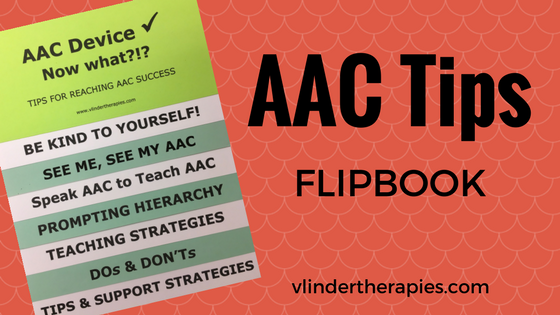AAC Tips Flipbook

- I get to see weekly
- I get to work with directly
- I usually (whenever possible) invite the parent to observe and try to involve them in the therapy session so that I can teach and coach regarding their child's communication system and needs
- while I have an open door policy (inviting any team member to attend my therapy sessions with our shared child), I get very little interaction with other team members which makes it more difficult for us all to stay on the same page regarding the communication intervention for the client
- in my "isolation", it is also extremely difficult to collaborate with other team members and for me to help support/incorporate what other team members are working on
- typically, there is not funding for me to attend meetings regarding the client
The consultation-based clients:
- I do not typically see consistently/on a regular basis (and in some cases, my services are only funded for a specific period of time - e.g. x number of hours over x number of months - and then I will never be involved again)
- After doing my evaluation, I typically do not have the opportunity to work directly with the client; my focus is on training family/staff/other team members as well as providing guidance and recommendations within a collaborative/consultative model
- I typically have more flexibility to interface directly with multiple team members, including attending meetings
- include a wider-range of ages, generally older elementary through adult, all with developmental disabilities and complex communication needs
Within BOTH sides of my practice, I have had a growing frustration regarding how to pass on key information to all team members (and in a way that they can remember even when I'm not there/available) when implementing AAC. Let's face it - there is an overwhelming amount of information to learn when first starting down the path of implementing AAC...and a lot to remember over the long-haul (it's easy to let slip some key strategies in the hubbub of every day life)!
And then a few months ago, I saw this AAC 101 Flipbook from PrAACtical AAC. Flipbooks are not new. Just search on TPT (Teachers Pay Teachers) and you will see a huge variety of flipbooks for use as therapy activities or for sharing information. But silly me hadn't thought to apply it to my problem until I saw the PrAACtial AAC version. BUT. I needed an AAC Tips Flipbook that would work for my incredibly diverse AAC caseload. And so, I give you my version of the AAC Tips Flipbook:
Note: I print out the pages (using color paper for alternating pages), cut to size and laminate, trim, stack in order and coil bind along the top edge; for the back cover, I have added this Building Language - Where Do I Start worksheet (Speak For Yourself, modified)
My plan is to make a flipbook for each client/team when first implementing AAC and then use that as my springboard for training, focusing on one topic at a time, and leaving the flipbook with them as a reminder/reinforcer. I hope that it will also help facilitate conversations between parents and other team members when they are trying to help pass along what they have learned in therapy with me (no more trying to remember what I said - now it's written for them in the flipbook). Feedback has been good so far!
BONUS:
When getting feedback on a draft of the flipbook from a mentor/colleague (and fellow NWACS Board member), our discussion resulted in the idea for a "reminder" poster: "Have You AACed Today?" Hop on over to the NWACS blog to check out the companion poster!
You might also be interested in:
Aided-language what? How to model AAC
 Saturday, October 28, 2017 at 4:03PM
Saturday, October 28, 2017 at 4:03PM  Post a Comment →
Post a Comment →  AAC,
AAC,  AAC Awareness Month | in
AAC Awareness Month | in  AAC,
AAC,  flipbooks
flipbooks
Reader Comments